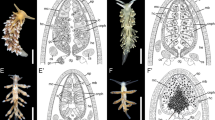Abstract
Based on laboratory observations of three species of Allothyrus (Parasitiformes: Holothyrida: Allothyridae) from south east Queensland and gut content analysis of 62 individuals representing 11 species of Allothyrus from eastern Australia, we determined that Australian Allothyridae are scavengers that ingest fluids only. Living arthropods, nematodes, snails and annelids were ignored, but dead arthropods were readily fed upon and were sufficient to maintain adults and nymphs for many months. The adults were sluggish, timid animals that relied on armour, thanatosis and probably on noxious chemicals for protection: the juveniles produced secretions from idiosomal glands. In contrast, most early derivative Mesostigmata that we tested (Sejina, species of Sejus and Uropodella; Uropodina, Polyaspis sp. and Cercomegistina, an undescribed Asternoseiidae) were aggressive predators of small invertebrates and ingested fluids only; however, two species of Asternolaelaps (Sejina) had solid fungal and animal material in their guts. Similarly, the early derivative acariform (Palaeosomata, species of Stomacarus and Loftacarus) and opilioacariform mites (an undescribed Opilioacarida from Australia) that we examined all ingested particulate foods, including fungal and animal material. These observations are consistent with the hypothesis that the earliest mites were scavengers and opportunistic predators that ingested solid foods and that fluid feeding is a derived condition linking the three orders of Parasitiformes (Holothyrida, Ixodida and Mesostigmata).
Similar content being viewed by others
REFERENCES
Alberti, G. 1995. Comparative spermatology of the Chelicerata: review and perspective. Mem. Mus. Nat. Hist. Nat. 166: 203–230.
Arnaud, F. and Bamber, R.N. 1987. The biology of Pycnogonida. Adv. Mar. Biol. 24: 1–263.
Athias-Henriot, C. 1972. Gamasides Chiliens (Arachnides) II. Revision de la famille Ichthyostomatogasteridae Sellnick 1953 (= Uropodellidae Camin, 1955). Arquivos de Zoologia Sao Paulo 22: 113–191.
Beron, P.K. 1990. On the occurrence of Opiloacarus segmentatusWith, 1903 (Arachnida, Opiloacarida) on the islands of Kassos, Karpathos and Rhodes (Greece). Acta Zool. Bulgarica 39: 64–66.
Camin, J.H. 1954 Polyaspis berlesi, a new species of trachytoid mite (Mesosostigmata: Polyaspidae). Bull. Chi. Acad. Sci. 10: 25–33.
Coineau, Y. and van der Hammen, L. 1979. The postembryonic development of Opilioacarida, with notes on new taxa and on a general model for the evolution. In Proceedings of the Fourth International Congress of Acaralogy, E. Piffl (ed.), pp. 437–441. Akadémiai Kiadó, Budapest.
Domrow, R. 1955. A second species of Holothyrus(Acarina: Holothyroidea) from Australia. Proc. Lin. Soc. NSW 74: 159–162.
Dunlop, J.A. 1997. Palaeozoic arachnids and their significance for arachnid phylogeny. In Proceedings of the 16th European Colloquium on Arachnology, pp. 65–82.
Evans, G.O. 1992. Principles of Acarology, CAB International, Cambridge.
Hutu, M. 1991. Reproduction, embryonic and postembryonic deleveopment of Trichouropodis obscurasimilis
Hirschmann & Zirngiebl-Nichol 1961 (Anactinotrichida: Uropodina). In The Acari. Reproduction, development and life-history strategies, R. Schuster and P.W. Murphy (eds), pp. 287–299. Chapman & Hall, London.
Johnston, D.E. 1982. Acari. In Synopsis and classification of living organisms, S.P. Parker (ed.), p. 111. McGraw-Hill, New York.
Kaiser, T. and Alberti, G. 1991. The fine structures of the lateral eyes of Neoacarus texanusChamberlin and Muliak, 1942 (Opilioacarida, Acari, Arachnida, Chelicerata). Protoplasma 163: 19–33.
Krantz, G.W. 1978. A Manual of Acarology, 2nd edn. Oregon State University Bookstores, Corvallis.
Lee, D.C. and Southcott, R.V. 1979. Spiders and other arachnids of South Australia. In South Australian Yearbook, D.J. Woolman, (ed.), Government Printer, South Australia.
Lehtinen, P.T. 1981. New Holothyrina (Arachnida, Anactinotrichida) from New Guinea and South America. Acaralogia 22: 3–13.
Lehtinen, P.T. 1991. Phylogeny and zoogeography of the Holothyrida. In Modern acaralogy, Vol. 2, F. Dusabek and V. Bukva (eds), pp. 101–113. SPB Academic Publishers, The Hague.
Lehtinen, P.T. 1995. Revision of the Old World Holothyridae (Arachnida: Anactinotrichida: Holothyrina). Invert. Taxon. 9: 767–826.
Lindquist, E.E. 1984. Current theories on the evolution of major groups of Acari and on their relationships with other groups of Arachnida, with consequent implications for their classification. In Acaralogy VI, Vol. 1, D.A. Griffiths and C.E. Bowman (eds), pp. 28–62. John Wiley & Sons, New York.
OConnor, B.M. 1984. Acarine-Fungal relationships: the evolution of symbiotic associations. In Fungus-Insect relationships, perspectives in ecology and evolution, Q. Wheeler and M. Blackwell (eds), pp. 354–381. Columbia University Press, New York.
Phillipson, J. 1960. A contribution to the feeding biology of Mitopus morio(F) (Phalangida). J. Animal Ecol. 29: 35–43.
Proctor, H.C. 1993. Mating biology resolves trichotomy for cheliferoid pseudoscorpions (Pseudoscorpionida, Cheliferoidea). J. Arachnol, 21: 156–158.
Proctor, H.C. 1998. Indirect sperm transfer in arthropods. Annu. Rev. Entomol. 43: in press.
Ruppert, E.E. and Barnes, R.D. 1994. Invertebrate Zoology, 6th edn. Saunders College Publishing, Toronto.
Seeman, O.D. 1996. Flower mites and phoresy: the biology of Hattena panoplaDomrow and Hattena cometisDomrow. Austr. J. Zool. 44: 193–203.
Seeman, O.D. and Walter, D.E. 1995. Life history of Afrocypholaelaps africana(Evans) (Parasitiformes: Ameroseiidae), a mite inhibiting mangrove flowers and phoretic on honeybees. J. Austr. Entomol. Soc. 34: 45–50.
Selden, P.A. and Jeram, A.J. 1989. Paleophysiology of terrestrialisation in the Chelicerata. Trans. R. Soc. Edinburgh, Earth Sci. 80: 303–310.
Southcott, R.V. 1976. Arachnidism and allied syndromes in the Australian region. Records Adelaide Children's Hospital 1: 97–186.
Travé, J. 1982. Premières observations sur le comportement de Thonius braueri(Thon, 1906) (Holothyrida). Acaralogia 23: 199–206.
van der Hammen, L. 1989. An Introduction to Comparative Arachnology. SPB Academic Publishing, The Hague.
Walter, D.E. 1987. Trophic behavior of ‘mycophagous’ microarthropods. Ecology 68: 226–229.
Walter, D.E. 1988. Predation and mycophagy by endeostigmatid mites (Acariformes: Prostigmata). Exp. Appl. Acarol. 4: 159–166.
Walter, D.E. and Lindquist, E.E. 1989. Life history and behavior of ascid mites in the genus Lasioseius(Acari: Mesostigmata) from grassland soils in Colorado with taxonomic notes and a description of new species. Can. J. Zool. 67: 2797–2813.
Wernz, J.G. and Krantz, G.W. 1976. Studies on the function of the tritosternum in selected Gamasida (Acari). Can. J. Zool. 54: 202–213.
Woodring, J.P. and Galbraith, C.A. 1976. The anatomy of the adult uropodid Fuscouropoda agitans(Arachnida: Acari), with comparative observations on the other Acari. J. Morphol. 150: 19–58.
Rights and permissions
About this article
Cite this article
Walter, D.E., Proctor, H.C. Feeding behaviour and phylogeny: observations on early derivative Acari. Exp Appl Acarol 22, 39–50 (1998). https://doi.org/10.1023/A:1006033407957
Issue Date:
DOI: https://doi.org/10.1023/A:1006033407957




